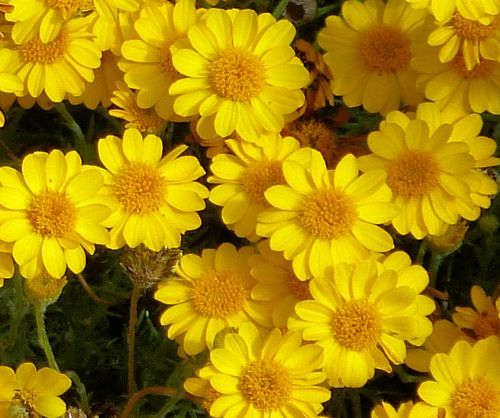Growing Thymophylla pentachaeta:
Golden Dyssodia
Description
Form: An herb which may develop a woody root crown with age, becoming a subshrub.
Lifespan: Perennial.
Leaf retention: Evergreen.
Growth rate: Moderate.
Mature Size: 6-10" (15-25cm) high and somewhat wider.
Flowers: Yellow rays surrounding orange disc florets, 1/2" (12mm) diameter, at the ends of stalks.
Bloom: This plant is a repeat bloomer and may bloom all year in regions without freezes.
Fruit: Each floret produces a dry fruit with a single seed (cypsela).
Leaves: Green, lacy, thread-like, with soft tips. Leaves and stems have a foul aroma if crushed when green. Dried, brown leaves have hardened tips and are uncomfortable to touch.
Stems: Green to gray-green, densely covered in fine hairs.
Roots: This plant grows a taproot.
Wildlife: The flowers attract butterflies and other insects. This plant hosts caterpillars of the Dainty Sulphur butterfly. The foliage is avoided by browsing animals.
Toxic / Danger: All parts of the plant are toxic.
Origin: California through Texas, Nevada, Utah, Mexico.
Form: An herb which may develop a woody root crown with age, becoming a subshrub.
Lifespan: Perennial.
Leaf retention: Evergreen.
Growth rate: Moderate.
Mature Size: 6-10" (15-25cm) high and somewhat wider.
Flowers: Yellow rays surrounding orange disc florets, 1/2" (12mm) diameter, at the ends of stalks.
Bloom: This plant is a repeat bloomer and may bloom all year in regions without freezes.
Fruit: Each floret produces a dry fruit with a single seed (cypsela).
Leaves: Green, lacy, thread-like, with soft tips. Leaves and stems have a foul aroma if crushed when green. Dried, brown leaves have hardened tips and are uncomfortable to touch.
Stems: Green to gray-green, densely covered in fine hairs.
Roots: This plant grows a taproot.
Wildlife: The flowers attract butterflies and other insects. This plant hosts caterpillars of the Dainty Sulphur butterfly. The foliage is avoided by browsing animals.
Toxic / Danger: All parts of the plant are toxic.
Origin: California through Texas, Nevada, Utah, Mexico.
Cultivation and Uses
USDA hardiness zones: 7-10. This plant dies to the ground in hard freezes.
Heat tolerant: Yes.
Drought tolerant: Yes.
Sun: Full sun.
Soil: Well draining, dry, low in organic content, pH 6.6-8.5 (neutral to alkaline).
Water once established: Twice a month. Supplemental water improves performance, but the soil must dry out between waterings. This plant is subject to root rot if overwatered.
Prune: After freezing temperatures are past, remove dead stems or cut the plant nearly to the ground. It recovers quickly in warm temperatures.
Mulch: Decomposing granite may improve growth. Small gravel may extend drought tolerance. Organic mulch is undesirable because it will prevent the soil from drying quickly.
Litter: No, except for freeze damage.
Propagation: Seed. This plant freely reseeds and will eventually cover a wide area in disturbed ground.
Uses: Ornamental, ground cover.
USDA hardiness zones: 7-10. This plant dies to the ground in hard freezes.
Heat tolerant: Yes.
Drought tolerant: Yes.
Sun: Full sun.
Soil: Well draining, dry, low in organic content, pH 6.6-8.5 (neutral to alkaline).
Water once established: Twice a month. Supplemental water improves performance, but the soil must dry out between waterings. This plant is subject to root rot if overwatered.
Prune: After freezing temperatures are past, remove dead stems or cut the plant nearly to the ground. It recovers quickly in warm temperatures.
Mulch: Decomposing granite may improve growth. Small gravel may extend drought tolerance. Organic mulch is undesirable because it will prevent the soil from drying quickly.
Litter: No, except for freeze damage.
Propagation: Seed. This plant freely reseeds and will eventually cover a wide area in disturbed ground.
Uses: Ornamental, ground cover.
Comments
This plant is a member of the Daisy family (Asteraceae). Another common name is Dogweed. The butterfly is a male Checkered White.
Do you have additional information or a different experience for these plants that you would like to share? Email info@GardenOracle.com. All contributions are welcome and appreciated.
This plant is a member of the Daisy family (Asteraceae). Another common name is Dogweed. The butterfly is a male Checkered White.
Do you have additional information or a different experience for these plants that you would like to share? Email info@GardenOracle.com. All contributions are welcome and appreciated.



Latest update: October, 2024
© 2008-2025 by GardenOracle.com

